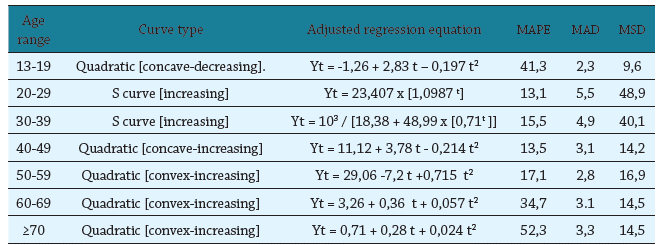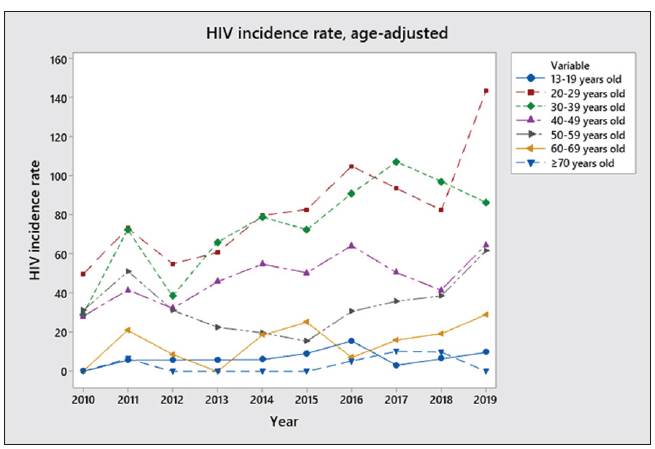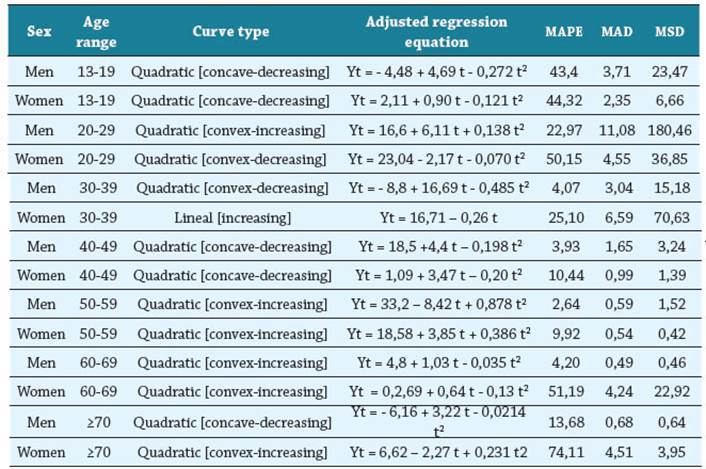INTRODUCTION
The Atacama Desert in northern Chile is the oldest and most arid non-polar environment on Earth. It is a coastal desert covering approximately 180,000 km and, together with the Atacama region, comprises a dramatically wide range of ecological niches and mining activity, offering immense potential for future development. 1,2 Economically, the Atacama region is characterized as an area with a concentration of mining activity, the most important sector in regional development. 3
Factors such as natural hazards, poor socioeconomic conditions, and low literacy levels affect traditional miners and contribute to multiple health vulnerabilities. 4 Precisely, there is evidence of high HIV incidence in mining production areas, which is estimated to be due to these types of factors. 5 Controlling the spread of HIV is becoming increasingly important in the fight against HIV/AIDS. Several sociological and structural factors make general control strategies ineffective in different settings, including the mining environment. 6 In addition, informational and educational factors have been shown to be deficient in HIV prevention in the Chilean population. 7
It is estimated that each miner supports between 7 and 10 dependents and that the employment of each miner leads to the creation of an additional job in the economy. Remittances from mining are also important to the countries' economies. HIV/AIDS disease is likely to negatively affect mining productivity through increased miner absenteeism and mortality. This will be accompanied by increased expenditures on recruitment, processing and training of new miners, and health care, death, funeral, and other death-related benefits for miners. Data suggest that 10-20% of miners are infected with HIV. 8
Tere is broad agreement on the high health impact of HIV on those who are undiagnosed or diagnosed late. Tis high impact translates into the persistence of the epidemic by an unintended increase in transmission, even more so when the rate of HIV diagnostic testing is low, suggesting that many others remain undiagnosed. 9,10
Therefore, diagnostics in HIV-positive persons have played a central role in the remarkable progress in the identification, staging, initiation, and follow-up of infected persons. They are also useful in surveillance and outbreak responses, allowing for the assessment of disease burden and identification of vulnerable populations, which enables planning, appropriate interventions, and the allocation of adequate funds. 11
HIV is responsible for one of the largest viral pandemics in human history. Despite having a concerted global response for prevention and treatment, the virus persists. Therefore, urgent public health actions, using novel interventions, are needed to prevent future transmission events critical to eliminating HIV. Effective and successful public health planning requires understanding the dynamics of regional epidemics and intervening appropriately. Numerous applications with HIV suggest that epidemiological methods combined with mathematical models can provide inferences about transmission dynamics or spatiotemporal characteristics of the epidemic. 12
Large projects in the extractive industries sector can affect the health and well-being of people. People's health is of particular concern in these contexts because of potential educational and economic disadvantages, vulnerability to transactional sex, and risky sexual practices. At the same time, community health interventions and development initiatives provide opportunities for people experiencing these types of vulnerabilities. 13
The objective of this article is to evaluate HIV incidence curves in an economically mining region, according to age and sex, since, in other countries, it has been found that middle-aged populations with HIV/AIDS showed the highest infection and there were significant regional differences in the geographic distribution of HIV/AIDS prevalence. 14
MATERIALS AND METHODS
The data for the diagnostic confirmation of HIV seropositive patients was performed by the Biomedical Laboratory Department of the Institute of Public Health of Chile (ISPCH). 15
Data from 2010 to 2017 was used. The population was adjusted by year, age, and sex based on population estimates and projections by sex according to simple age 2002-2020, from the National Institute of Statistics of Chile (INE) 16.
HIV incidence rates were constructed from confirmed cases. A general trend analysis was performed (not adjusting for sex) to reflect the behavior at the national level. Finally, we adjusted for sex and age range to verify the trend over the period.
The values of the specific rates adjusted for age and sex were used for descriptive analysis in tables and simple arithmetic graphs. Subsequently, a trend analysis was applied to these data and the trend regression equations were estimated with the best fit of the data to the curve and the following were estimated: mean absolute percentage error (MAPE) (expresses accuracy as a percentage of the error of the regression equation estimate), mean absolute deviation (MAD) (expresses accuracy in the same units of the data), and mean squared deviation (MSD) (measures the accuracy of the values of the time series). The program used was Minitab 18.0. The significance level was α ≤ 0.05.
RESULTS
Table 1 presents the results of the trends, types of curves, and age-adjusted regression equation for new HIV-positive cases in the Atacama region of Chile. The generalized characteristic observed in this table is that there is a tendency for HIV-infected persons to grow and that the forms of growth are different according to age, which implies that the increasing behavior of the infection process is differentiated.
Table 1 Results of HIV incidence rate trends, types of curves and regression equations, adjusted for age. Atacama Region, Chile (2010-2017)

Source: Biomedical Laboratory Department of the Institute of Public Health of Chile and National Institute of Statistics of Chile (INE). Own elaboration.
Figure 1 shows the trend of HIV incidence by age group. The groups with the highest incidence were 20-29 years, 30-39 years, and 40-49 years. Te analysis of the curve and its trend showed that the growth curve of the 20-29 years age group is the strongest.

Source: Biomedical Laboratory Department of the Institute of Public Health of Chile and National Institute of Statistics of Chile (INE). Own elaboration.
Figure 1 HIV incidence rate trend (per 100,000 population) by age group. Atacama Region, Chile (2010-2017)
Table 2 presents the results of trends, curve types, and age-adjusted regression equation of HIV-infected patients considering sex. It was observed that, in some age ranges, both men and women decrease, however, in men, the growth and growth prognosis of the 20-29 years age group is stronger, followed by the group of men aged 50-59 years. Precisely, the group of men aged 2029 years is the one with the highest growth in all groups (both men and women). In the case of women, the 50-59 and 60-69 age group are the fastest growing, and their growth forecast is also the fastest growing, however, it is a slower growth than in the case of men.
Table 2 Results of HIV incidence rate trends, types of curves and regression equations, adjusted for sex and age. Atacama Region, Chile (2010-2017)

Source: Biomedical Laboratory Department of the Institute of Public Health of Chile and National Institute of Statistics of Chile (INE). Own elaboration.
DISCUSSION
The mathematical model of any process attempts to describe its basic components and tries to predict some general trends. Te model presented here can only provide a basis for an understanding mechanism. Some aspects limit the predictive ability, and one must be attentive to changes in the determinants that may explain the behavior of HIV incidence. One of the transcendental aspects in epidemiology is to attempt the prediction of the evolution of infectious diseases, such as HIV transmission. 17
Chile has one of the fastest growing HIV epidemics in the world, leading the percentage of new cases in Latin America, surpassing countries with lower HDI (Human Development Index) and GDP (Gross Domestic Product) per capita. This study shows that one of Chile's regions, in which its economy is basically mining, has worrying indicators in the HIV incidence rate in people aged 20-29 years and 50-59 years. Particularly, the mentioned rate is especially high and tends to rise in the population of men between 20-29 years and 50-59 years. It is estimated that this group is closely linked to the mining population, which indicates the importance of the relationship between mining activity and the rising incidence of HIV infection. On the other hand, the increasing number of people diagnosed with HIV among the population aged 50-59 years could be related to both high-risk exposure and late diagnosis in this population, which calls for early screening of the sources of HIV infection and adaptation of HIV prevention strategies in this population. In addition, it remains to consolidate this estimate and close the gap of HIV-positive people who are unaware of their health status. 7,18,19
Urgent measures must be taken to curb the spread of HIV among miners and in the communities surrounding the mining industry context. Public health policies have failed to provide an effective response to this long-standing threat to mining-related populations. In part, this reflects the lack of commitment of institutions or governments to public health, institutions, and the predisposing factors of the social determinants of health. Had public health institutions focused first on the needs of the most vulnerable populations, including miners and their communities, the focus of the questions currently being asked would be different and the results would potentially be more fruitful in turning the tide on HIV and other preventable mining epidemics in the long term. From a political standpoint, advancing regional and national policy to implement safeguards seen elsewhere where the same mining companies operate has been described as a stalemate. The risks of disease for miners are high and potentially higher given the burden of HIV. 8,20
It is imperative to recognize that the plight of miners literally reflects that there is a social production underlying the HIV epidemic, with the understanding that this group is among the most vulnerable communities. Researchers engaged in this field need to use the key tools of public health and epidemiology: the combination of ethnographic and survey-based methods to investigate the constraints facing the lives of miners and their families, and the collection of large-scale data and epidemiological metrics to identify the keys to change, because HIV/AIDS-related stigma is prevalent and contributes to low testing rates and hiding diagnoses of seropositivity. Identifying factors that contribute to stigma, such as insufficient or inaccurate knowledge of HIV/AIDS can be critical to increasing early identification and treatment. Programs and interventions that increase knowledge about HIV/AIDS can reduce stigmatizing attitudes toward people living with HIV. 9,20
On the other hand, mining production areas are characterized by high levels of migration. Particularly mining activity, due to its work systems, favors intra- and interregional displacement; however, they are not immigrants in the usual sense, since these groups work for periods in the mines and temporary sites, go home, and then return (oscillating or circular migration). 5,21
Research findings in the mining population suggest that increased awareness and risk perception among migrants could improve health-related behaviors. In this regard, it is important to reinforce strategies that encourage regular testing for HIV and other infections in this population, in addition to intensifying appropriate communication interventions on HIV transmission and prevention methods in these communities. Therefore, policy development and implementation of health programs at all levels is needed to reduce health disparities between migrants and non-migrants, improving the health status of the entire community. Another group that deserves consideration and is part of the key populations to control HIV infection are men who have sex with men (MSM) and transgender people. More effective services, improved surveillance, and scaling up HIV interventions in these groups together are critical to achieve further reduction in HIV prevalence, while not neglecting testing and treatment in the commercial sex user population. 4,6,21,22
The goal of ending the HIV/AIDS pandemic is theoretically achievable and would require addressing this global health catastrophe at the individual and global level by providing optimal prevention strategies and treatment regimens for people living with or at risk of HIV. However, from a practical standpoint, the path to ending the HIV/AIDS pandemic will be difficult and will require aggressive implementation of the biomedical research advances that have been made in the areas of treatment and prevention; development of additional tools, such as a moderately-highly effective HIV vaccine; and attention to critical social and behavioral determinants. Ending the HIV/ AIDS pandemic can only be achieved with the provision of additional and sustained resources from the local to the global level. 23
National surveillance is needed to understand the epidemiology of HIV infection in the country. Identification of risk factors and targeted health outreach to the public are fundamental prevention measures that should be implemented by the governing body in health. Continued monitoring of health outcomes and broader determinants of health after the initial assessment is crucial to judge the project's influence on health and to reduce inequities over time. 13,24
CONCLUSIONS
We highlight changes that have occurred in domains that are fundamental to epidemiological science, such as: understanding key populations at increased risk of HIV, improvements in measurement in outcomes of interest, and a new era in epidemiological tools and approaches used to synthesize evidence from population-based measurements. By embracing fundamental principles with modern methods, the epidemiological approach to analyzing the causes and distributions of disease in contemporary populations will continue to drive HIV science over the next decade. 25 This study is valuable to health policy planners, given the importance of controlling communicable diseases such as HIV/AIDS, which this underserved population acquires.















